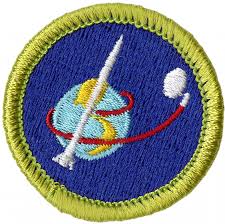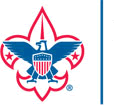Space Exploration Merit Badge

Space Exploration Merit Badge Requirements:
1. Tell the purpose of space exploration and include the following:
(a) Historical reasons
(b) Immediate goals in terms of specific knowledge
(c) Benefits related to Earth resources, technology, and new products
(d) International relations and cooperation
2. Design a collector’s card, with a picture on the front and information on the
back, about your favorite space pioneer. Share your card and discuss four
other space pioneers with your counselor.
3. Build, launch, and recover a model rocket.* Make a second launch to accomplish a specific objective. (Rocket must be built to meet the safety code of the
National Association of Rocketry. See the “Model Rocketry” chapter of the
Space Exploration merit badge pamphlet.) Identify and explain the following
rocket parts.
(a) Body tube
(b) Engine mount
(c) Fins
(d) Igniter
(e) Launch lug
(f) Nose cone
(g) Payload
(h) Recovery system
(i) Rocket engine
4. Discuss and demonstrate each of the following:
(a) The law of action-reaction
(b) How rocket engines work
(c) How satellites stay in orbit
(d) How satellite pictures of Earth and pictures of other planets are made
and transmitted
5. Do TWO of the following:
(a) Discuss with your counselor a robotic space exploration mission and a
historic crewed mission. Tell about each mission’s major discoveries, its
importance, and what was learned from it about the planets, moons, or
regions of space explored.
(b) Using magazine photographs, news clippings, and electronic articles (such
as from the internet), make a scrapbook about a current planetary mission.
(c) Design a robotic mission to another planet, moon, comet, or asteroid that
will return samples of its surface to Earth. Name the planet, moon, comet, or
asteroid your spacecraft will visit. Show how your design will cope with the
conditions of the environments of the planet, moon, comet, or asteroid.
6. Describe the purpose, operation, and components of ONE of the following:
(a) Space shuttle or any other crewed orbital vehicle, whether government owned (U.S. or foreign) or commercial
(b) International Space Station
7. Design an inhabited base located within our solar system, such as Titan,
asteroids, or other locations that humans might want to explore in person.
Make drawings or a model of your base. In your design, consider and plan for
the following:
(a) Source of energy
(b) How it will be constructed
(c) Life-support system
(d) Purpose and function
8. Discuss with your counselor two possible careers in space exploration that
interest you. Find out the qualifications, education, and preparation required
and discuss the major responsibilities of those positions.
*If local laws prohibit launching model rockets, do the following activity: Make a model of a NASA rocket. Explain the functions of the parts. Give the history of the rocket.


